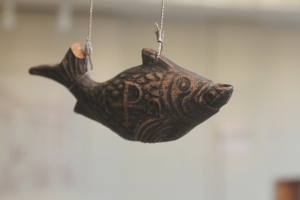Byzantine and Christian Museum of Athens
photo © vbouzas
Image: “One Hundred Fish Fountain,” 2005, ninety-seven bronze fish of seven different forms, suspended with stainless steel wire from a metal grid © Bruce Nauman
Computer Art > Multimedia Art > New Media
- art that uses digital technologies as a tool
- art that uses digital technologies as its own medium
Technical History of Digital Art
- limited to military, academic, and consumer cultureo As We May Think by army scientist Vannevar Bush imagined the
first computero Men, Machines and the World Apart by Norbert Wiener - 1946 – ENICA the University of Pennsylvania created the first digital computer
- 1961 – Theodor Nelson coined the terms Hypertext and and Hypermedia to describe texts in which images and sounds could be linked
- 1964 – RAND Corporation (Cold War think tank) conceptualized the internet as a communication network without central authority that could be safe from a nuclear attack
- 1968 – Douglas Engelbart from the Stanford Research Institute created came up with the idea of bitmapping, windows, and direct manipulation through a mouse
o Bitmapping: each pixel of a computer screen is a assigned on/off (0-1). The computer screen could then be divided into a grid of pixels that create a 2D image - 1970’s – Alan Kay of the Xerox Parc in Palo Alto, CA developed the GUI (graphical user interface), and the “desktop” metaphor popularized bu Apple in 1983
Evolution of Digital Art
- developed in connection to Dada and Fluxus: conceptual art has challenged the traditional notions of the art work, audience, and artist
- 1984 – William Gibson coined the term “cyberspace” in his novel Neruomancer
- 1990’s – Digital art began making it’s way into museums and galleries
- digital arts festivals
o ICC (Tokyo, Japan)o ZKM (Karlsruhe, Germany)o Ars Electronica (Linz, Austria)o Transmediale (Berlin, Germany) o SIGGRAPH (Los Angeles, USA)

